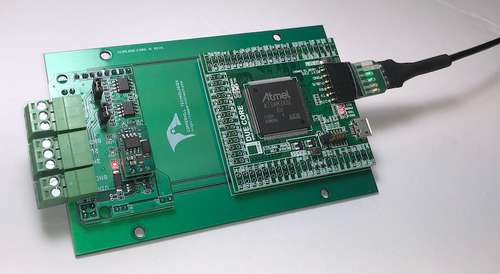Recent Posts
Computer-on-Module With 64-bit NXP i.MX8 Multi-Core ARM Processor Supports Two CAN Bus Ports
Posted by on
congatec announced the release of their conga-SMX8, a SMARC 2.0 Computer-on-Module based on the 64-bit NXP i.MX8 multi-core ARM processor family. The ARM Cortex-A53/A72 based conga-SMX8 represents the flagship module for embedded computer designs, offering the ARM processor with performance, graphics and numerous embedded features for all kinds of IIoT applications. It offers multi-core computing along with extended graphics capabilities for up to three independent 1080p displays or a single 4K screen. Further features of this industrial-strength system include hardware-based real-time and hypervisor support along with scalability as well as resistance against harsh environments and extended temperature ranges. All these characteristics make the SMARC 2.0 module meet the recent performance and feature set needed for embedded systems, industrial and IoT, as well as the mobility sector.
The SMARC 2.0 modules with NXP i.MX8 processors, hardware based virtualization and resource partitioning are designed for a range of stationary and mobile industrial applications including real-time robotics and motion controls. Since the modules are qualified for the extended ambient temperature range from -40°C to +85°C, they can also be used in fleet systems for commercial vehicles or infotainment applications in cabs, busses and trains as well as all the electric and autonomous vehicles.
The conga-SMX8 modules feature up to 8 cores (2x A72 + 4x A53 + 2x M4F), up to 8 GByte of LPDDR4 MLC or pseudo SLC memory and up to 64 GByte of non-volatile memory on the module. The interface set includes 2 x GbE including optional IEEE1588 compliant precision clock synchronization, up to 6 x USB including 1 x USB 3.1, up to 2 x PCIe Gen 3.0, 1 x SATA 3.0, 2 x CAN Bus, 4 x UART as well as an optional onboard Wi Fi/Bluetooth module with Wi-Fi 802.11 b/g/n and BLE. Up to 3 displays can be connected via HDMI 2.0 with HDCP 2.2, 2x LVDS and 1x eDP 1.4. For video cameras, the modules support 2 MIPI CSI-2 video inputs. The new NXP i.MX8 based SMARC 2.0 modules come as application-ready super components including U-Boot and complete Board Support Packages for Linux, Yocto and Android.
Features
- NXP i.MX8 ARM Cortex-A72, Cortex-A53 and Cortex-M4
- Advanced Graphics, Performance and Virtualization
- 3D Graphics up to 4K with HDMI 2.0 & LVDS
- Two CAN Bus (2.0B) Interfaces
- Vision Extensions, MIPI CSI-2 dual camera interface
- Extended longevity up to 15 years
- Temperature range up to -40°C .. +85°C
More Information
- Download/View the conga-SMX8 data sheet (PDF)...
- More Information...
Arduino-Due-Based USB Gateway With Two CAN Bus Ports
The Due Core is a compact version of the Arduino DUE. It integrates all peripherals required for the MCU, and all GPIO are connected to 2.54mm connectors. As a standard MCU core, the board has the following features:
- Compact size: All components are put on a 54 x 58mm 4-Layers PCB. All IOs are connected to a 116-pin 2.54 standard connector.
- Easy to use: All IOs are connected to 116pin 2.54 standard connector. It requires only a 5 VDC power supply to make it work.
- Stable design: High-quality 4-layer PCB layout, two 5V to 3.3V LDO onboard, one for digital and one for analog processing. Separate AVCC and AGND, to ensure optimum analog performance.
- Easy to set up the development environment: Uploading sketches through standard 6-pin UART interface, standard Micro usb connector, full use of existing resources.
- User-friendly design: Rich LED status indication, two onboard buttons, one is for MCU reset, and one is for Flash Erase. Unique jumper erase protection against the flash erased by mistake.
- Rich resources: All IOs are available for the user. The onboard I2C EEPROM is designed to compensate for the shortcomings of the standard SAM3X8E, which has no built-in EEPROM.
The jCOM.DUE.CORE-B board is powered either by the USB port connection (either the programming or native USB) or through an external power supply supporting an input voltage of 7 to 36 VDC.
 Loading... Please wait...
Loading... Please wait...


